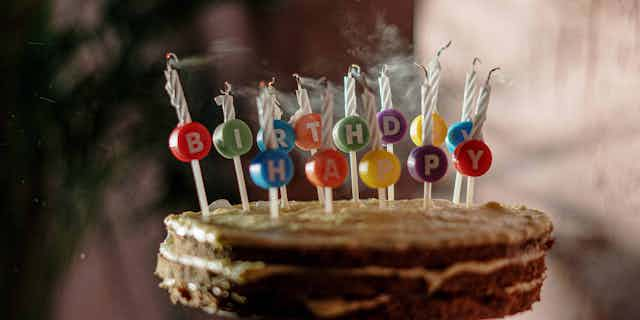Have you ever bumped into someone with the same birthday as you? What about someone sharing a birthday in your workplace? How common is a shared birthday, anyway?
The birthday problem, as it’s called by mathematicians, reveals problems with our understanding of number theory, probabilities and our assumptions of how the world works. It comes back to how counter-intuitive maths is for a lot of people.
In the birthday problem you are asked “what’s the minimum number of people in a room to get better than 50% chance of two people having the same birthday?” A simple question with a puzzling answer.
To get a more intuitive understanding of this problem we’ve created an interactive simulation, below. It arranges birthdays along a line, with January on the left and December on the right.
The intuitive answer is the wrong one
When the birthday problem is described to maths students for the first time, the majority of responses are that a group of 183 people is needed to have a better than even chance of two people having the same birthday.
The thinking here is: 183 is half of 365 (number of days in the year). Students assume they only need to compare others against a single person – themselves, and then try to match their birthday with other people.
If you use this assumption, you need to find 183 people to have an even chance of finding a person matching with you. However, when students understand that not every combination has to be with yourself – for example, person 2 and person 5 might be the right combination – it becomes clearer the number needed is lower than 183.
Combinations do not scale linearly
If you’ve been playing with the interactive above you may have come across the answer to the birthday problem: only about 23 people are needed for a greater than 50% chance of a shared birthday. But how can this be if there are 15 times more days in the year?
We’ve created another interactive below to visualise how the connections between people in a room do not scale linearly as you add more people. Play around with adding a node and see if you can guess how many connections should be added.
It should give you a better grasp of factorial growth through multiplication, which is the area of number theory that underpins the birthday problem.
Large numbers are hard to comprehend
The COVID-19 pandemic showed the world most of us have a limited understanding of exponential growth when presented with models of what could occur if the pandemic were left unchecked.
There are many great examples of the ill-understood power of exponential growth, but one I often use is asking this question: would you take $1 million on the first day of the month only, or one cent on the first day of the month, doubled each day until the end of the month (30 days)?
Nearly all people choose the $1 million lump sum. However, if you choose the one cent option, you end the month with approximately 10 times more money due to the effect of exponential growth.
In a similar tale, the supposed inventor of chess requested to sell their game to a king for some rice. They proposed placing a single grain on the first tile and doubling it each tile. The amount of rice on the final tile would be the sale price.
As you can see below, that number can very quickly become larger than the entire world’s rice supply.
Asking ‘what comes next’ is seldom simple
Another real world example of counter-intuitive mathematics was on the roulette wheels in Monte Carlo in 1913. There was a run of 26 straight black results, which is improbable but not impossible.
One striking aspect of the story is that gamblers increasingly bet on red as the run of blacks continued, thinking red was “due”. However, the mathematics says otherwise. Each spin of the roulette wheel has no memory of what happened before, so the chance of red appearing does not increase as time goes on. In short, lots of people lost money that night!
However, some situations do rely on the probabilities of what came before. For example, in the Monty Hall problem you are trying to win a car, which is hidden behind one of three doors (the others have goats). You are given the option to pick a door, then shown a different door with a goat.
The question is: should you stay with your first pick or switch doors? Try it out with the game below.
The assumption here is that after Monty shows you the goat then the odds of winning a car if you switch or stay are 50/50 – there are only two doors left and one of them has a car.
But that doesn’t take into account the likelihood that you originally picked a goat to begin with. Thus the chances of your next choice are informed by your previous choice.
Becoming numerate is important
These examples demonstrate the importance of being “numerate”, defined as being able to reason with numbers and being able to apply this reasoning in a range of contexts. The importance of developed numeracy skills cannot be understated, with correlations to better overall life outcomes such as employment, income, health and well being.
If people are highly numerate, they can understand how our world works at a deeper level, even if it doesn’t feel like it should work that way. Also, they are likely to have a better idea of what actions will yield the desired results in certain situations.
So, keep turning your mind to mathematical and numerical problems, they may just come in handy one day.

